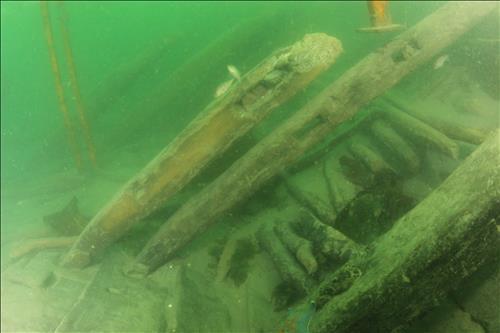- California Assembly OKs highest minimum wage in nation
- S. Korea unveils first graphic cigarette warnings
- US joins with South Korea, Japan in bid to deter North Korea
- LPGA golfer Chun In-gee finally back in action
- S. Korea won’t be top seed in final World Cup qualification round
- US men’s soccer misses 2nd straight Olympics
- US back on track in qualifying with 4-0 win over Guatemala
- High-intensity workout injuries spawn cottage industry
- CDC expands range of Zika mosquitoes into parts of Northeast
- Who knew? ‘The Walking Dead’ is helping families connect
S. Korean shipwreck found to date back to early Joseon

The above photo shows Mado No. 4 buried in the seabed off Mado Island, Taean County, South Chungcheong Province. (Courtesy of the Cultural Heritage Administration) (Yonhap)
SEOUL (Yonhap) — A shipwreck discovered in South Korea’s southwestern waters last year was found to date back to the early Joseon Dynasty in what is believed to be the nation’s first discovery of a Joseon-era ship, a research institute said Wednesday.
After a four-month study into the Mado No. 4 ship, the National Research Institute of Maritime Cultural Heritage announced that it believes the ship carried rice collected as tax by provincial governments to the capital Seoul in the early years of the Joseon Dynasty (1392-1910).
The ship was discovered in the seabed off Mado Island, Taean County, South Chungcheong Province, in April last year along with some 140 “buncheong-ware” ceramics from the Joseon era.
The conclusion is based on the relics, including the ceramics and wooden tablets, recovered from the shipwreck and the ship’s relatively solid structure, the research institute said.
Most of the 60 or more wooden tablets have the words “Naju” and “Gwangheungchang” written on them, meaning that the ship departed from the city in South Jeolla Province and headed to Gwangheungchang, the name of a major rice granary during the period.
“The wooden tablet served as a luggage tag, just like ones from other shipwrecks discovered in waters off Mado Island,” Im Kyeong-hee, a curator of the Cultural Heritage Administration, told reporters. “We can also see a small hole for tying a strap in undamaged tablets.”
“The fact that wooden tablets bearing the words ‘Naju-Gwangheungchang’ were found en masse is clear proof that this ship was for carrying rice collected as tax,” she said, stressing that they became the first 15th-century wooden tablets unearthed in East Asia.
Three of the roughly 140 ceramics from the ship had the word “Naeseom” inscribed on them, which was a government office in charge of managing items for use in palaces, according to the institute.
Buncheong refers to ceramics with a gray or bluish-green body, decorated with white. It is associated with the earlier part of the dynasty.
“We believe the ship sunk in waters off Mado Island while heading to Gwangheungchang carrying goods from Naju in the period ranging from the 1410s to 1420s,” the institute said.
Excluding the ship, 13 ancient shipwrecks have been found in South Korea up until now. Among them, 10 are thought to be from the Goryeo Dynasty, which preceded Joseon, two from 13th-14th century China and one from the Unified Silla (668-918).
But this marked the first time that a Joseon-era ship was identified in the country’s history of maritime archeology and excavation.















